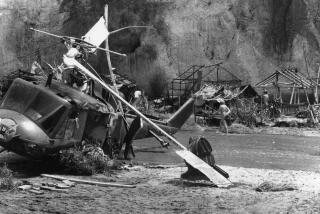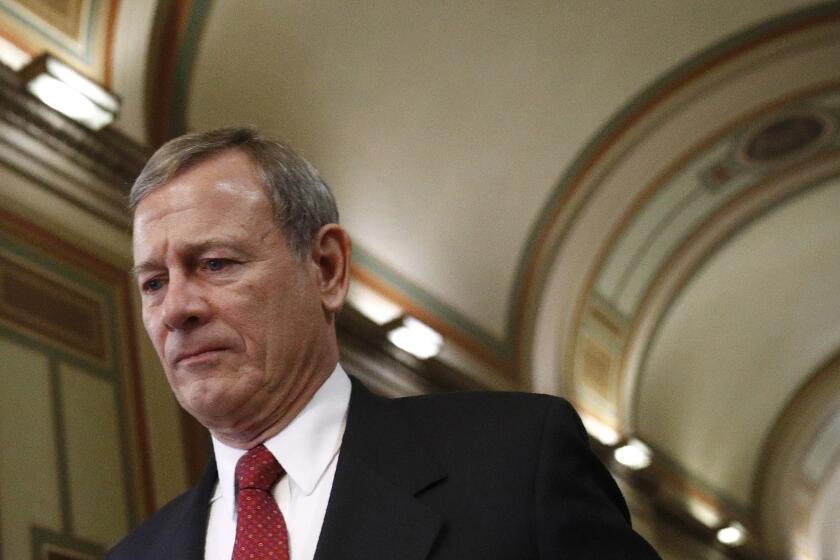Prosecutors Rest Their Case Against McVeigh
- Share via
DENVER — Their case began four weeks ago with the testimony of victims and it ended Wednesday with victims on the stand.
In between, prosecutors in the Oklahoma City bombing trial put on swift, tough and compelling evidence as they sought to show that Timothy J. McVeigh is the worst mass murderer in the history of this country.
At 10 minutes to noon Wednesday, prosecutors rested their case--a case built largely on circumstantial evidence. It deftly tied McVeigh to the bombing that rocked Oklahoma City and blasted the nation’s confidence that it was safe from domestic terrorism.
The government’s chief witness, Michael Fortier, delivered for the prosecution even more than had been expected, telling a rapt jury that McVeigh was so intent on killing federal workers that he was prepared to crash a bomb-laden Ryder truck into the front doors of the Alfred P. Murrah Federal Building.
The defendant’s sister, Jennifer McVeigh, identified his handwriting on a series of letters he had written, many of them railing against the government, one even threatening federal law enforcement officials with this epithet: “Die, you cowardice bastards.”
And dozens of receipts collected by FBI agents seemed to pin McVeigh to large purchases of ammonium nitrate, leases on storage lockers and the rental application for a 20-foot-long Ryder truck.
Added to that were a dozen survivors and relatives of the 168 people killed in the explosion. They took the witness stand one at a time, bringing the tears and agony of April 19, 1995, into the U.S. District Courthouse here.
But the government’s case was not fail-safe.
Prosecutors skipped over the weak points, avoiding testimony on how, where or when the ammonium nitrate and fuel oil bomb was mixed and placed into the truck. Nor did they have any witnesses who could place McVeigh in Oklahoma in the hours or minutes before the blast.
There are other key discrepancies in the government’s case, all of which the defense is likely to try to exploit when it opens its case this morning.
For example, Lea McGown, owner of a Junction City, Kan., motel where McVeigh stayed in the days before the bombing, insists that she saw him with a Ryder truck the day before the owner of the Ryder agency said it was rented.
Tom Kessinger, a Ryder employee, testified that he was sure McVeigh was accompanied by a second, shadowy man who came to be known only as John Doe No. 2. What was his role in the bombing?
There is also Daina Bradley, a young mother severely injured in the bombing, who remembers seeing a man other than McVeigh step out of the passenger side of the truck moments before it incinerated the front of the Murrah building.
And there are sweeping questions about the FBI’s crime laboratory in Washington and the fact that several lab officials who worked on the Oklahoma City explosion were suspended and removed from their jobs in the midst of a critical audit by the Justice Department inspector general’s office.
Stephen Jones, the lead defense attorney, needs only to raise a reasonable doubt in the jurors’ minds about the government’s case. He has said in the past that may require no more than simply confusing the jurors about what really happened at 9:02 a.m. that day.
In the center of the action sits U.S. District Judge Richard P. Matsch. He has run a tight schedule, 9 to 5 daily, sometimes ordering prosecutors to bring in another witness with just minutes left before the court has recessed for the day.
And he has shown irritation when the trial seemed to slow. On Tuesday, when defense attorney Chris Tritico asked FBI lab official Steven Burmeister to quietly examine a document on the witness stand, the judge grew impatient. Two minutes of quiet time was too long for Matsch.
“What are we doing, reading every page of this?” the judge snapped. To many courtroom observers, Matsch seems to be sending a clear message about how he believes a trial should be run.
The government began its case with Cynthia Klaver, a lawyer for a state agency across the street from the Murrah building. She was conducting a hearing at the time of the blast, and they played for the jury the audiotape from the hearing that depicted not only the roar of the bomb but also the cries and panic that followed.
Their last witness was Dr. Frederick Jordan, the medical examiner in Oklahoma City, who verified for the jury a stack of death certificates two inches thick.
In between, the government called 136 witnesses, some of them for multiple appearances, plus one who appeared via videotape because of illness. His name is Thomas Manning. He is the man who sold McVeigh a 1977 Mercury Marquis, which the government says was the getaway car.
But the government’s case was about much more than witnesses.
It included high-tech computer graphics, video presentations, chunks and bits and pieces of a blasted-away Ryder rental truck, hundreds of pages of documents, tiny individual phone records, motel receipts, ammonium nitrate receipts, storage locker receipts--even, for several days, a snappy, large-scale model reproduction of downtown Oklahoma City where once stood the landmark Murrah building.
Using McVeigh’s letters and recollections from his former friends, prosecutors strongly indicated that the 1993 FBI raid near Waco, Texas, in which 80 cult members died was the primary force behind McVeigh’s anger against the government.
Using a book called “The Turner Diaries,” McVeigh’s favorite novel, prosecutors tried to establish that it was a blueprint for destruction in that its fictional hero helps blow up the FBI headquarters building in Washington.
And using forensic evidence, prosecutors elicited testimony which showed that McVeigh’s clothing and a set of earplugs carried traces of chemical components found in explosive materials.
But the coup de grace seemed to be Michael and Lori Fortier. The Kingman, Ariz., couple, once friends of McVeigh, turned against him after the bombing. In a deal with the government, Michael Fortier pleaded guilty to reduced charges and agreed to testify against McVeigh in return for the promise of a reduced sentence. Lori, his wife, was granted immunity from prosecution in return for her testimony.
Michael Fortier appeared in court in a new brown suit. His wife appeared in sharp, business-like attire. They separately provided the most intimate details of McVeigh’s hatred for the government and his plans to avenge the deaths of Branch Davidian cult members near Waco.
But it was one line in the 160 hours of government witness testimony that chilled the courtroom and captured the essence of why prosecutors want McVeigh to pay with his life for the lives of the Oklahoma City victims.
“If he had to,” Michael Fortier testified, “he was going to drive the truck down the stairs and crash it through the front doors.”
More to Read
Sign up for Essential California
The most important California stories and recommendations in your inbox every morning.
You may occasionally receive promotional content from the Los Angeles Times.











